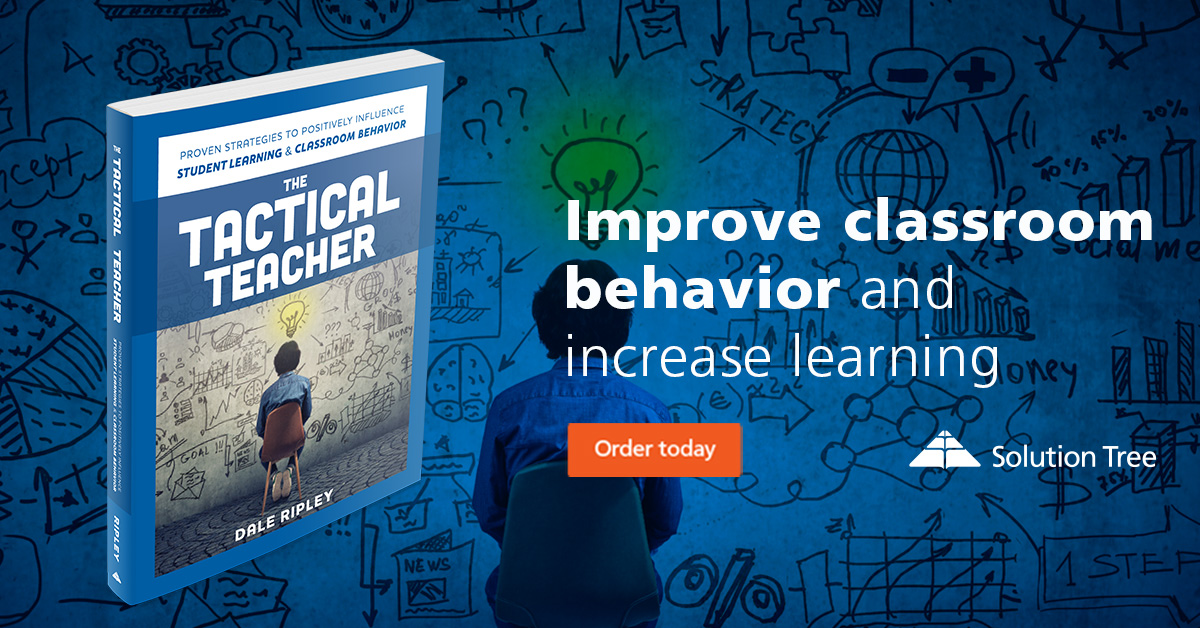Having worked in high-needs schools with “at risk” students for most of my career, I learned quickly that trying to use teacher authority with defiant or disengaged students was rarely effective. Instead, I developed strategies that I call soft tactics to get students to a place where success in school matters to them.
Soft Tactic #1: Being present for your students
The first strategy I use is to make a commitment to be there for the long haul. During our first week together, I tell my students that their success at school matters to me and that no matter how tough things get, I am not going away.
I make a commitment to them that I will show up every day, that I will be prepared with lessons that are relevant to them and their lives, and that if I don’t show up, they should check the obituaries because that is the only reason I would not be there for them.
Then, I honor that commitment. While many students don’t believe me at first, after several months of showing up daily with a positive attitude and genuine concern for their success, I eventually wear them down.
If you truly want to make a difference in the lives of your students, I suggest the following:
- Let them know that you will always be there for them.
- Show up every day well-prepared and ready to teach them.
- Stand firm; no matter how badly they treat you, you aren’t going anywhere.
- Be there when they don’t deserve it. Be there when they do.
- Be there when they fight with you.
Because their future depends on it, let them see, feel, and know that you will be there for them because you believe they are worth it—even if they don’t. That’s what I mean by making a commitment.
Soft Tactic #2: Making space for a love of learning
The basic classroom truth is that students don’t learn well from teachers or in classrooms they don’t like. So, I do many things to ensure my students like me and enjoy class, such as being festive: I give candy at Halloween, candy canes at Christmas, and chocolate on Valentine’s Day and at Easter.
I also pay very close attention to the classroom’s physical environment as a way to appeal to students (mostly at the subconscious level) so that they will be motivated to come to school and work. What students hear, what they see, and what they smell in my classroom all impact how they feel about being there and doing the work. By using music, certain visuals, and specific colors in the classroom (including giving students ownership of specific areas of the room), I create an environment that is pleasant for them to be in and conducive to getting the work accomplished.
Other tactics, such as making students continually aware of their standing regarding attendance and academic progress, using empathetic persuasion, using rewards effectively, and using cognitive bias strategies such as loss aversion and focusing illusion, all work to get students to a place where they are motivated to come to school and to do well.
Soft Tactic #3: Focusing on powerful relationships with students
Another strategy that I find very effective in motivating and engaging students is likeability. Likeability is very influential—and it may be the extra push a student needs to make a small commitment to doing some schoolwork.
We know that we all like people similar to us in some way. There is a lot of research that supports the fact that we tend to like people who are like us. So, very early in the school year, I implement strategies that help me gather information about each student in my class, such as asking:
- What music do they like?
- What video games do they play?
- What sports do they play or follow?
- What are their favorite TV shows or movies?
I then use this information to establish similarities with students, especially the more challenging ones. In addition, I often help and support my students in myriad ways—sometimes school-related, sometimes in their personal lives. It is really hard to dislike someone who constantly shows you that they are concerned about you and they are consistently there for you.
Don’t give up! How a walk with a student taught me a powerful lesson
Several years ago, I was asked to set up a high school on a First Nations reserve. The school’s director was a friend, and she told me that their attempts to establish an effective high school were not working well. She thought I could help. So I went to the reservation to take a look.
What I observed were bored and often absent students. I agreed to see if we could build a more supportive high school for these kids, where all students could engage with learning—so I began teaching there. At first, the students hated me! In their eyes, I had no business being there and nothing to offer them.
“They swore at me—sometimes in English, other times in Cree—sometimes in a whisper, other times loudly. That was the start of the school year in the fall.”
However, later things began to change. One day, I was walking around the building after a spring school concert, ensuring all the doors were properly shut and locked, when a young high school student of mine, who I will call Annie, began walking with me, chatting about the concert, her friends, school, and so on. It was about 9:00 p.m.
What was this 16-year-old doing walking the hallways of the school helping me on a beautiful spring evening? I wondered. She was popular and had a lot of friends. Surely, she had better things to do.
So I asked, “Annie, why are you here? You have many other things to do, but here you are, helping me. When I first started teaching here last fall, you hated me! You refused to do any work. You yelled at me in English class, saying you won’t read and write! What’s changed? You and the other kids are so nice to me now. Seriously, I want to know. What happened?”
Annie then proceeded to teach me a lesson I have never forgotten, one that is at the heart of what it means to be a good teacher . . .
“Well, Ripley,” she replied, smiling. “You’re right. We did hate you back then. You wanted us to come to school and made us work when we didn’t want to. You were pushy and demanding and always wanted more.”
She continued, “So we made a bet on how long it would take us to get you to quit. We were mean to you, swore at you, and refused to do any work because we figured you would quit. But you didn’t. You kept coming back. You came every day. You never even took a sick day. Finally, after several months, you just wore us out, and we gave up. We knew that no matter how badly we treated you, you would show up the next day anyway and try to teach us.”
At the end of the school year, Annie, this same young lady (the one who yelled at me in our first English class, “I don’t read and I don’t write!”) wrote me a beautiful letter about all she had learned that year and what a great experience the year had been for her.
Want to keep learning? Here are some additional handpicked resources on motivating and engaging students in challenging school environments.
Dale Ripley is the author of The Tactical Teacher: Proven Strategies to Positively Influence Student Learning and Classroom Behavior.







